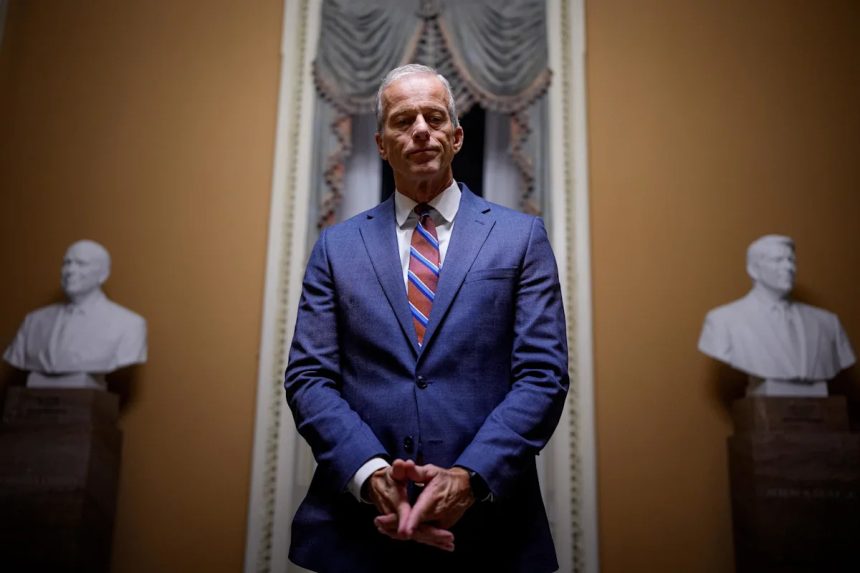Washington — The longest government shutdown in history came to an end on Wednesday after weeks of gridlock causing air travel disruptions, denying access to food benefits to millions and forcing thousands of federal workers to go without paychecks.
After 43 days and more than a dozen attempts to reopen the government, President Trump signed the funding package, passed by the Senate and House, into law late Wednesday, meaning the funding lapse is officially over.
Here’s how the shutdown started, and eventually came to an end:
A Senate standoff
The standoff began in late September as lawmakers faced a deadline to fund the government by the start of a new fiscal year on Oct. 1. House Republicans passed a short-term funding measure on Sept. 19 to keep the government funded at existing levels until Nov. 21. But with Democratic support needed to move forward with any funding measure in the Senate, the chamber was at an impasse.
The top Democrats in Congress had been pushing since August to meet with GOP leaders and the White House on the funding issue, ramping up their calls to address expiring health care tax credits as the Oct. 1 shutdown deadline drew near.
Senate Minority Leader Chuck Schumer and House Minority Leader Hakeem Jeffries brief members of the press on the government shutdown at the U.S. Capitol on Oct. 16, 2025 in Washington, D.C. / Credit: Alex Wong / Getty Images
With few opportunities to exert influence with a GOP-controlled House, Senate and White House, Democrats set out to center health care issues in the funding fight — setting their sights on the expiring health insurance tax credits as their key demand. The credits, under the Affordable Care Act, help millions of Americans pay for health insurance premiums for plans purchased on state exchanges. Their expiration would mean eye-popping increases in insurance costs for those with ACA plans.
Months earlier, Senate Minority Leader Chuck Schumer faced intense pushback for voting to advance a GOP measure during the last funding fight, increasing the pressure on him to dig in this time around.
Democrats sought to negotiate, introducing a counter-proposal to the House-passed measure to fund the government that included their health care demands. But Republicans remained steadfast in their belief that health care and other issues should be negotiated outside the context of funding the government, and urged Democrats to agree to a “clean” temporary funding extension.

Senate Republicans speak to members of the media following a lunch in the Rose Garden of the White House in Washington, DC, US, on Tuesday, Oct. 21, 2025. / Credit: Allison Robbert / Bloomberg via Getty Images
Over the course of seven weeks, Republicans and Democrats traded blame for the funding impasse. Senate Republicans put forward the House-passed funding measure for a vote 14 times, seeking to peel off support from Democrats as the caucus remained largely united in their opposition. But throughout it all, member-level bipartisan conversations seeking an offramp were bubbling under the surface.
As the weeks dragged on, the real-world effects of the shutdown began to take their toll, raising the stakes for the continuing stalemate and pushing Democrats to make a deal. Millions of federal workers began missing paychecks, straining those with little savings or no access to credit. Chaos began to emerge at airports after the Trump administration said it would reduce flight traffic amid staffing shortages caused by strained air traffic controllers. And millions of Americans were at risk of losing access to food aid under the Supplemental Nutrition Assistance Program, or SNAP.
A bipartisan undercurrent
As early as the first days of the shutdown, a small group of moderate senators began signaling tepid interest in finding a way out at the member level, while leaders refused to engage.
What began as a large bipartisan huddle on the Senate floor would go on to involve a number of senators from across both the Democratic caucus and Republican conference.
The conversations across the aisle ramped up as the shutdown neared the longest on record. Sen. Katie Britt, an Alabama Republican and appropriator, told reporters on Oct. 30 she had spoken with Schumer to “lay the foundation” on continued appropriations work. And although Schumer didn’t vote for the final deal to end the shutdown, the long-term funding efforts became a key to unlocking an eventual agreement by demonstrating Republicans’ willingness to work on the appropriations process on a bipartisan basis.

Sen. Katie Britt, Republican of Alabama, arrives for Senate votes to reopen the government on day 41 of the government shutdown at the U.S. Capitol in Washington, DC, on Nov. 10, 2025. / Credit: SAUL LOEB/AFP via Getty Images
The contours of the eventual deal began to emerge during the first week of November, with senators discussing an agreement that would fund the government alongside a trio of long-term appropriations bills. In exchange for their support, Democrats would be promised a vote on extending health insurance tax credits that they had demanded.
Britt told reporters on Nov. 4 that she made calls through the prior weekend on the funding package, saying she was hopeful it could be part of what ends the stalemate. Sen. Mike Rounds, a South Dakota Republican involved in the talks, said on the same day that the appropriations package might entice Democrats to “vote for something other than just simply a continuing resolution” while providing “a path forward” beyond a vote on the health care tax credits. And Democrats involved in the talks generally remained tight-lipped, signaling that things were close.
But the impasse would stretch on for a few more days, after Democrats swept key races in off-year elections. The victories emboldened the holdouts, who argued that voters had given them marching orders not to cave on their health care demands.
Meanwhile, House Speaker Mike Johnson made clear that he would not commit to a vote on the health insurance tax credits in the lower chamber. That comment underlined concerns from some Democrats that a future Senate vote on health care, which they were set to receive as part of a deal to reopen the government, would go nowhere.

House Speaker Mike Johnson speaks during a news conference on Nov. 4, 2025 on Capitol Hill in Washington, D.C. / Credit: Tom Brenner / Getty Images
Still, the shutdown’s toll on Americans continued to ratchet up pressure on senators to reach a resolution.
On Nov. 7, Senate Democrats presented an offer to Republicans, saying they would end the government shutdown in exchange for a one-year extension of the health care tax credits and a plan to continue broader talks. But the proposal was swiftly rejected by Republicans as a “nonstarter,” as Senate Majority Leader John Thune maintained the position that negotiations on health care could only come after the government reopened.
The long-sought breakthrough
On Nov. 9, the deal to end the shutdown finally came together, with a group of eight Democrats agreeing to advance a funding measure as part of a broader agreement to end the shutdown.
Led by Sens. Jeanne Shaheen and Maggie Hassan of New Hampshire and Sen. Angus King of Maine, the deal they struck with Thune and the White House secured a vote in December on the Affordable Care Act tax credits. The deal attached the trio of full-year funding bills, while restoring food aid at higher levels, and paving the way for a bipartisan appropriations process on other spending bills. And it reversed all government layoffs that occurred during the shutdown, while preventing them for a limited time going forward.

Sen. Tim Kaine, a Virginia Democrat, speaks at a press conference with other Senate Democrats who voted to restore government funding, in Washington, D.C. on Nov. 9, 2025. / Credit: Nathan Posner/Anadolu via Getty Images
The moderates viewed the deal — after Republicans leaders refused Schumer’s offer — as the best possible offer they could secure, arguing that continuing the shutdown would only inflict more pain without any hopes of a better deal.
The final turn seemed to come with the provision in the bill that would address the Trump administration’s layoffs. Sen. Tim Kaine of Virginia, one of the eight Democrats to back the funding deal, had long called the issue his principal priority in the shutdown fight. And he said he joined the group of Democrats just 48 hours before the deal was announced.
GOP Sen. Markwayne Mullin of Oklahoma told reporters that the language in the new continuing resolution reversing the layoffs came from the White House. Mullin said the White House told Republicans they were willing to revert the layoffs if it could help win Kaine over.
“It was the right provision which brought him over, which brought a couple other people over, too,” Mullin said. “That’s what got it over the finish line.”
With coordination with the House and White House, the deal was on a glidepath to passage in the lower chamber, and to swiftly secure the president’s signature.
The House passed the bill late Wednesday, and Mr. Trump signed it during an Oval Office ceremony hours later. He applauded congressional Republicans and the Democratic senators who voted for the deal, while lashing out at most other Democrats.
“We’re sending a clear message that we will never give in to extortion,” he said.
Jack Schlossberg, John F. Kennedy’s grandson, announces bid for Congress
Passengers wait hours as air traffic control staffing issues due to shutdown disrupt travel
White House reacts to Epstein emails released by House Oversight Committee Democrats









